Civil/Human Rights
>
Spraktrollet
>
English
>
Themes
The Life of Malala Yousafzai. Feat Marc Copage. Justice Ruth Bader Ginsburg’s legacy on the Supreme Court. Directions: Read the summary, watch the video and answer the discussion questions.
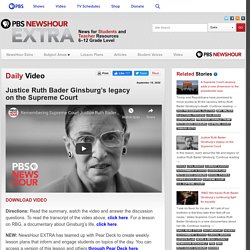
To read the transcript of the video above, click here. For a lesson on RBG, a documentary about Ginsburg’s life, click here. NEW: NewsHour EXTRA has teamed up with Pear Deck to create weekly lesson plans that inform and engage students on topics of the day. You can access a version of this lesson and others through Pear Deck here. Summary: Supreme Court Justice Ruth Bader Ginsburg, who long stood for women’s rights issues and became the court’s second female justice, died Friday at her home in Washington D.C.
One of Ginsburg’s most significant majority opinions included the 1996 ruling that ordered the Virginia Military Institute (VMI) to accept women or lose federal funding. Political implications:
Civil rights and social activists - KS1 History - BBC Bitesize. The life of Mary Seacole - BBC Teach. History KS1 / KS2: Rosa Parks - BBC Teach. History KS1 / KS2: Harriet Tubman - BBC Teach. Who was Rosa Parks? - BBC Bitesize. Voices of Alabama - World Monuments Fund. Green book - en överlevnadsguide. The real story of the Green Book. Laura Bates: Everyday sexism. Who is CHRISTIAN PICCIOLINI?
Nelson Mandela - Biographical. Questions and answers on Nelson Mandela Nelson Rolihlahla Mandela was born in Transkei, South Africa on July 18, 1918.
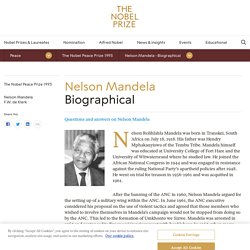
His father was Hendry Mphakanyiswa of the Tembu Tribe. Mandela himself was educated at University College of Fort Hare and the University of Witwatersrand where he studied law. He joined the African National Congress in 1944 and was engaged in resistance against the ruling National Party’s apartheid policies after 1948. He went on trial for treason in 1956-1961 and was acquitted in 1961. After the banning of the ANC in 1960, Nelson Mandela argued for the setting up of a military wing within the ANC.
During his years in prison, Nelson Mandela’s reputation grew steadily. Nelson Mandela was released on February 11, 1990.
Imagine all the people comic strip. John Lennon's "Imagine," Made Into a Comic Strip. The Civil Rights Movement. Civil Rights Movement: Educational Equality. Women voyagers, Breaking boundaries. Freedom rides. Civil Rights. Good Enough: One Man's Memoir on the Price of a Dream. How the Parkland Students Pulled off a Massive National Protest in Only 5 Weeks. The following article from CNN describes how Parkland students launched a movement after the 2018 mass shooting at Marjory Stoneman Douglas High School.
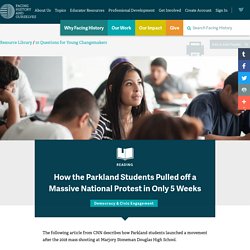
Just five weeks ago, a gunman killed 17 of their friends and teachers at school and changed the course of their lives. This weekend, the students of Marjory Stoneman Douglas High School led a historic march for gun control, what they called a March for Our Lives. Here's how the Parkland, Florida, students went from experiencing a mass tragedy to launching a mass movement. They took immediate action Within days of the February 14 shooting, the students made clear that thoughts and prayers were not enough for them -- they wanted concrete legislative solutions to the epidemic of mass shootings and an end to the influence of the National Rifle Association.
When Differences Matter. How do our beliefs about difference influence the ways in which we see and choose to interact with each other?
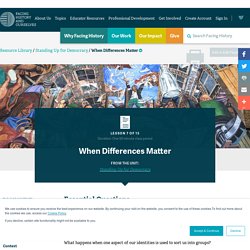
What happens when one aspect of our identities is used to sort us into groups? Students will recognise that when one aspect of our identity is privileged above others by members of society, it can affect how we see ourselves, how we see others, and the choices we ultimately make. In the last lesson, students examined the range of responses that individuals and groups can have when they encounter difference, and they looked in their own communities for examples and echoes of behaviours described in a poem by James Berry. In this lesson, students will continue to examine how we respond to difference by considering what happens when one aspect of our identities, in this case eye colour, is elevated above others and carries with it power, privilege, and opportunity.
The Philosophy of Nonviolence. The purpose of this lesson is to help students Understand the goals of the nonviolence movement, especially the concept of the Beloved Community Understand the rationale of using nonviolence as a strategy to achieve the Beloved Community Consider how the philosophy of nonviolence can inform responses to injustice and violence today This first lesson, in a series of three that focus on nonviolence, helps students understand the goals and rationale that provided a foundation for the philosophy of nonviolence as advocated by activists in the civil rights movement, including James Lawson, Martin Luther King Jr., Diane Nash, Bayard Rustin, John Lewis, Ella Baker the Southern Christian Leadership Conference, the Student Nonviolent Coordinating Committee, and many others.

Ok?
MLK Nobel Prize lessons. Ruby Bridges: Connecting Lives. Black History in America Teaching Guide. Overview This Unit Plan supports the Culture and Change: Black History in America student activities.
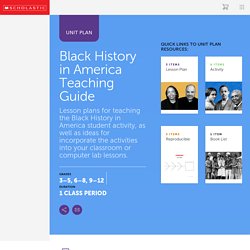
Students get an in-depth look into the African American experience in this unique online activity. Through interviews, historical sketches, interactives, and the lessons provided in this teacher's guide, students learn about important individuals, study the civil rights movement and the concept of racism, and explore the history of jazz music. Culture and Change: Black History in America also includes activities that allow students to share their thoughts and feelings about topics discussed.
Ruby Bridges: A Simple Act of Courage; Facts and Photos for Kids. Culture & Change: Black History in America. A Brief(ish) Timeline of Education in the U.S.
Civil Rights Movement: Desegregation. Medium.com Nazis in our classes The 50 year old lesson about fascism still terrifying usnbsptoday. Vox - In 1954 only 8 out of the 100 motels in Albuquerque,...
Martin Luther King, Jr. - BrainPOP. Human Rights versus Civil Rights - NotEnoughGood.com. Khanacademy. Susan B. Anthony - Women’s History. Born on February 15, 1820, in Adams, Massachusetts, Anthony grew up in a politically active family.
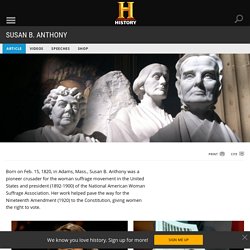
They worked to end slavery in what was called the abolitionist movement. They were also part of the temperance movement, which wanted the production and sale of alcohol limited or stopped completely. Anthony was inspired to fight for women’s rights while campaigning against alcohol. She denied a chance to speak at a temperance convention because she was a woman. Anthony later realized that no one would take women in politics seriously unless they had the right to vote. Along with activist Elizabeth Cady Stanton, Anthony founded the National Woman Suffrage Association in 1869. Anthony was tireless in her efforts, giving speeches around the country to convince others to support a woman’s right to vote. When Anthony died on March 13, 1906, women still did not have the right to vote.
I, Too, Sing America. Patriotism's a pretty complicated concept.
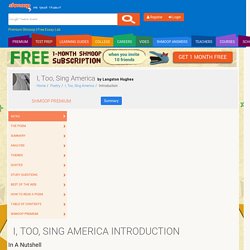
It can mean standing up for your country or criticizing it. If you want to sum up patriotism, you can simply call it "love for one's country.
" But how does one love a country? Unconditionally?
Break the norm second edition 2009. Teaching Tolerance - Diversity, Equity and Justice. PBS LearningMedia: Civil Rights Educator Review. Civil Rights Movement. The Abolition of Slavery Project. Dr. Martin Luther King Jr. Articles & Videos. Skip to main content <div id="nojs-warning">WARNING: Javascript must be enabled for the correct page display</div> Sign InRegister ReadWorks.org The Solution to Reading Comprehension Search form ReadWorks Dr.
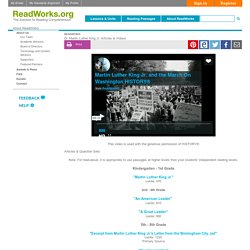
Share now! Print. The Story of Martin Luther King Jr. by Kid President. Free English Lessons Online - Martin Luther King Jnr.
King: Man Of Peace In A Time of War. Martin Luther King, Jr. Lesson. Martin Luther King, Jr.
Advertisement.
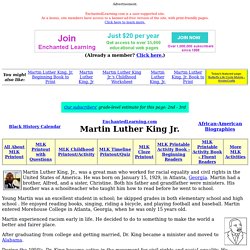
EnchantedLearning.com is a user-supported site. As a bonus, site members have access to a banner-ad-free version of the site, with print-friendly pages.Click here to learn more. (Already a member? Click here.)
Martin Luther King, Jr.
Comment:Last Updated:5 September, 2014Section:Resources Martin Luther King, Jr. Martin Luther King, Jr. an American Baptist minister changed history through his non-violent approach to tackling race issues in America.
He was a key player in the Civil Rights Movement and his campaigns improved the lives of Black citizens of America and the world. His famous “I have a dream” speech still continues to inspire today.
Celebrating MLK Day. Updated: Jan., 2014 In recognition of Martin Luther King Jr. Day, here is a collection of New York Times, Learning Network and other materials for teaching and learning about Dr. King, the civil rights movement he led and his legacy. Selected Times Resources Historical Front Pages and Articles. Martin Luther King Jr. Day: Facts, Timeline, History, Activities, Bio. Freedom’s Ring: King’s “I Have a Dream” Speech. The I Have a Dream speech by Martin Luther King. "I have a dream..." (Washington D.C., August 28th, 1963)
Martin Luther King I Have a Dream Speech - American Rhetoric.
Martin Luther King, Jr. I Have a Dream delivered 28 August 1963, at the Lincoln Memorial, Washington D.C. Video Purchase Off-Site audio mp3 of Address [AUTHENTICITY CERTIFIED: Text version below transcribed directly from audio. (2)]
Civil Rights Movement Heroes for Kids (Rosa Parks, Martin Luther King Jr.)
By Borgna Brunner The civil rights movement of the 1950s and 1960s challenged racism in America and made the country a more just and humane society for all. Below are a few of its many heroes.
Rosa Parks. Rosa Parks, born Rosa Louise McCauley (February 4, 1913 - October 24, 2005) was a pivotal figure in the fight for civil rights.
She was a protester of segregation laws in the US, and her actions led to major reforms (changes), including a Supreme Court ruling against segregation. Arrested for Not Giving up Her Bus Seat to a White Man On December 1, 1955, a Montgomery, Alabama, bus driver ordered Mrs. Parks to give up her seat to a white man.
Institute For Self Development. RosaParks. What can Teachers Learn from Nelson Mandela to Make a Difference?
We teach language to help people communicate. Why do people want to communicate?
To express the human story through myth, inspiration and powerful transformation.
BBC Scotland Education - History - Free at Last:Timeline Enhanced Version. African-American History: Black History Month. Celebrate Black History Month. Celebrate Black History Month 2016. Skip to main content. Teaching the Civil Rights Movement. Jeremy M. Lange for The New York TimesThe International Civil Rights Center and Museum opened in 2010 inside a former Woolworth building in Greensboro, N.C.
Civil War to Civil Rights - Time Line. Civil Rights. The Underground Railroad: Journey to Freedom. The Underground Railroad: Escape From Slavery Student Activity. Black News, Opinion, Politics and Culture. Strangers. "Can't Turn Me 'Round" (Civil Rights Song) performed by The Roots.
From NY to Texas, KKK recruits with candies and fliers. Your video will begin momentarily.
Engelska9 2014-15. Civil Rights Movement - Kids History Videos, Games and Lessons that Make Learning Fun and Easy. Civil Rights for Kids: Timeline. Search: civil rights. "Black Power" Era. Desegregation. Veterans of the Civil Rights Movement.
Search Results - History.com. The CNN Freedom Project: Ending Modern-Day Slavery - CNN.com Blogs. Civil Rights Movement. African-American Civil Rights Movement (1954–68)
The African-American Civil Rights Movement or 1960s Civil Rights Movement encompasses social movements in the United States whose goals were to end racial segregation and discrimination against black Americans and to secure legal recognition and federal protection of the citizenship rights enumerated in the Constitution and federal law.
AMERICAN EXPERIENCE: Freedom Riders: The Young Witness. The Story of Human Rights. BlackHistoryMonthBiographyforScienceWilliamKamkwamba.










